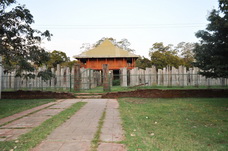Anuradhapura
Anuradhapura is one of the ancient capitals of Sri Lanka, famous for its well-preserved ruins of ancient Lankan civilization. From the 4th century BC, it was the capital of Sri Lanka until the beginning of the 11th century AD. During this period it remained one of the most stable and durable centers of political power and urban life in South Asia. The ancient city, considered sacred to the Buddhist world, is today surrounded by monasteries covering an area of over sixteen square miles (40 km²). Anuradhapura is also significant in Hindu legend as the fabled capital of the Asura King Ravana in the Ramayana.
View Anuradhapura City Map in a larger map
Anuradhapura Kingdome
The Anuradhapura Kingdom (Sinhala: අනුරාධපුර රාජධානිය), named for its capital city, was the first established kingdom in ancient Sri Lanka. Founded by King Pandukabhaya in 377 BC, the kingdom's authority extended throughout the country, although several independent areas emerged from time to time, which grew more numerous towards the end of the kingdom. Nonetheless, the king of Anuradhapura was seen as the supreme ruler of the country throughout the Anuradhapura period. Buddhism played a strong role in the Anuradhapura period, influencing its culture, laws, and methods of governance.
Society and culture were revolutionized when the faith was introduced during the reign of Devanampiya Tissa; this cultural change was further strengthened by the arrival of the Tooth Relic of the Buddha in Sri Lanka and the patronage extended by her rulers. Invasions from South India were a constant threat throughout the Anuradhapura period. Rulers such as Dutthagamani, Valagamba, and Dhatusena are noted for defeating the South Indians and regaining control of the kingdom. Other rulers who are notable for military achievements include Gajabahu I, who launched an invasion against the invaders, and Sena II, who sent his armies to assist a Pandyan prince. Because the kingdom was largely based on agriculture, the construction of irrigation works was a major achievement of the Anuradhapura Kingdom, ensuring water supply in the dry zone and helping the country grow mostly self-sufficient. Several kings, most notably Vasabha and Mahasena, built large reservoirs and canals, which created a vast and complex irrigation network in the Rajarata area throughout the Anuradhapura period.
These constructions are an indication of the advanced technical and engineering skills used to create them. The famous paintings and structures at Sigiriya; the Ruwanwelisaya, Jetavana stupas, and other large stupas; large buildings like the Lovamahapaya; and religious works (like the numerous Buddha statues) are landmarks demonstrating the Anuradhapura period's advancement in sculpting.
Technology used in Anuradhapura Kingdome
Advanced technology was required for the planning and construction of large reservoirs and canals. When constructing reservoirs, the gaps between low ridges in the dry zone plains were used for damming water courses. Two different techniques were used in construction; one method involved making an embankment using natural rock formations across a valley and the other involved diverting water courses through constructed canals to reservoirs.
All the reservoirs and canals in an area were interconnected by an intricate network, so that excess water from one will flow into the other. The locations of these constructions indicate that the ancient engineers were aware of geological formations in the sites as well, and made effective use of them. Underground conduits have also been constructed to supply water to and from artificial ponds, such as in the Kuttam Pokuna and the ponds at Sigiriya. The 54 miles (87 km) long Jayaganga has a gradient of six inches to the mile, which indicates that the builders had expert knowledge and accurate measuring devices to achieve the minimum gradient in the water flow.
The construction of Bisokotuva, a cistern sluice used to control the outward flow of water in reservoirs, indicates a major advancement in irrigation technology. Since the 3rd century, these sluices, made of brick and stone, were placed at various levels in the embankments of reservoirs.
















No comments:
Post a Comment